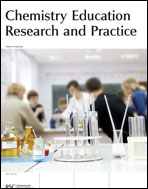Jigsaw cooperative learning: Acid–base theories
Abstract
This study focused on investigating the effectiveness of jigsaw cooperative learning instruction on first-year undergraduates' understanding of acid–base theories.Undergraduates' opinions about jigsaw cooperative learning instruction were also investigated. The participants of this study were 38 first-year undergraduates in chemistry education department in an education faculty in Izmir, Turkey. A prerequisite knowledge test was applied to both experimental (N = 18) and control groups (N = 20) before the treatment in order to identify undergraduates' prerequisite knowledge about ‘acids and bases’. Independent t-test was conducted to compare the prerequisite knowledge test scores for groups and no significant difference was found in terms of mean scores (t = 0.42, p > 0.05). The subject of “Acid–Base Theories” (Arrhenius, Brønsted–Lowry and Lewis Theories) was taught using jigsaw cooperative learning in the experimental group and with regular teacher-centered approach in the control group. After the instruction, the acid–base theories concept test was administrated to investigate undergraduates' conceptual understanding. Independent t-test results showed significant difference in terms of mean scores (t = 4.65, p < 0.05).The results also indicated that undergraduates in the experimental group had fewer misconceptions and understood the concepts more meaningfully than undergraduates in the control group. In addition, individual interviews reflected that undergraduates had positive opinion about jigsaw, and they believed jigsaw is an effective cooperative learning technique that promotes positive attitudes and interest, develop inter personal skills as well as their learning achievements.

 Please wait while we load your content...
Please wait while we load your content...